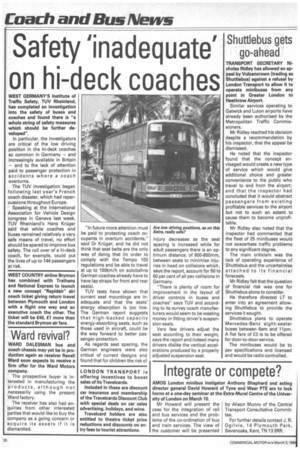Safety 'inadequate' on hi-deck coaches
Page 22

If you've noticed an error in this article please click here to report it so we can fix it.
WEST GERMANY'S Institute of Traffic Safety, TUV Rheinland, has completed an investigation into the safety of buses and coaches and found there is "a whole string of safety measures which should be further developed".
In particular, the investigators are critical of the low driving position in the hi-deck coaches so common in Germany — and increasingly available in Britain — and to the lack of attention paid to passenger protection in accidents where a coach overturns.
The TUV investigation began following last year's French coach disaster, which had repercussions throughout Europe.
Speaking at the International Association for Vehicle Design congress in Geneva last week, TUV Rheinland's Hans Kruger said that while coaches and buses remained relatively a very safe means of travel, no effort should be spared to improve bus safety. The roll over of a hi-deck coach, for example, could put. the lives of up to 144 passengers at risk. "In future more attention must be paid to protecting coach occupants in overturn accidents," said Dr KrEiger, and he did not think that seat belts are the only way of doing that (in order to comply with the Tempo 100 regulations and be able to travel at up to 100km/h on autobahns German coaches already have to have lap straps for front and rear seats).
TUV tests have shown that current seat mountings are inadequate and that the seats' energy absorption is too low. The German report suggests that high-backed capacity energy-absorbing seats, such as those used in aircraft, could be the way forward to better passenger-protection.
As regards seat spacing, the German engineers were also critical of current designs and found that for children the risk of injury decreases as the seat spacing is increased while for adult passengers there is an optimum distance, of 800-850mm, between seats to minimise injuries in head on collisions which, says the report, account for 50 to 60 per cent of all psv collisions in Germany.
"There is plenty of room for improvement in the layout of driver controls in buses and coaches" says TUV and according to its survey coach manufacturers would seem to be wasting money in fitting driver's suspension seats.
Very few drivers adjust the seat according to their weight, says the report and indeed many drivers dislike the vertical accelerations produced by a properly adjusted suspension seat.


































































































